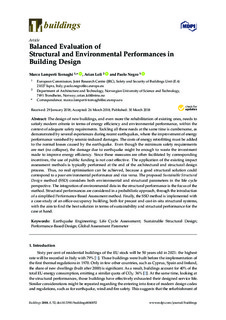| dc.contributor.author | Lamperti Tornaghi, Marco | |
| dc.contributor.author | Loli, Arian | |
| dc.contributor.author | Negro, Paolo | |
| dc.date.accessioned | 2018-09-10T07:35:50Z | |
| dc.date.available | 2018-09-10T07:35:50Z | |
| dc.date.created | 2018-03-30T21:15:00Z | |
| dc.date.issued | 2018 | |
| dc.identifier.issn | 2075-5309 | |
| dc.identifier.uri | http://hdl.handle.net/11250/2561618 | |
| dc.description.abstract | The design of new buildings, and even more the rehabilitation of existing ones, needs to satisfy modern criteria in terms of energy efficiency and environmental performance, within the context of adequate safety requirements. Tackling all these needs at the same time is cumbersome, as demonstrated by several experiences during recent earthquakes, where the improvement of energy performance vanished by seismic-induced damages. The costs of energy retrofitting must be added to the normal losses caused by the earthquake. Even though the minimum safety requirements are met (no collapse), the damage due to earthquake might be enough to waste the investment made to improve energy efficiency. Since these measures are often facilitated by corresponding incentives, the use of public funding is not cost effective. The application of the existing impact assessment methods is typically performed at the end of the architectural and structural design process. Thus, no real optimisation can be achieved, because a good structural solution could correspond to a poor environmental performance and vice versa. The proposed Sustainable Structural Design method (SSD) considers both environmental and structural parameters in the life cycle perspective. The integration of environmental data in the structural performance is the focus of the method. Structural performances are considered in a probabilistic approach, through the introduction of a simplified Performance Based Assessment method. Finally, the SSD method is implemented with a case-study of an office-occupancy building, both for precast and cast-in-situ structural systems, with the aim to find the best solution in terms of sustainability and structural performance for the case at hand. | nb_NO |
| dc.language.iso | eng | nb_NO |
| dc.publisher | MDPI | nb_NO |
| dc.rights | Navngivelse 4.0 Internasjonal | * |
| dc.rights.uri | http://creativecommons.org/licenses/by/4.0/deed.no | * |
| dc.title | Balanced Evaluation of Structural and Environmental Performances in Building Design | nb_NO |
| dc.type | Journal article | nb_NO |
| dc.type | Peer reviewed | nb_NO |
| dc.description.version | publishedVersion | nb_NO |
| dc.source.volume | 8 | nb_NO |
| dc.source.journal | Buildings | nb_NO |
| dc.source.issue | 4 | nb_NO |
| dc.identifier.doi | 10.3390/buildings8040052 | |
| dc.identifier.cristin | 1576312 | |
| dc.description.localcode | © 2018 by the authors. Licensee MDPI, Basel, Switzerland. This article is an open access article distributed under the terms and conditions of the Creative Commons Attribution (CC BY) license (http://creativecommons.org/licenses/by/4.0/) | nb_NO |
| cristin.unitcode | 194,61,55,0 | |
| cristin.unitname | Institutt for arkitektur og teknologi | |
| cristin.ispublished | true | |
| cristin.fulltext | original | |
| cristin.qualitycode | 1 | |

